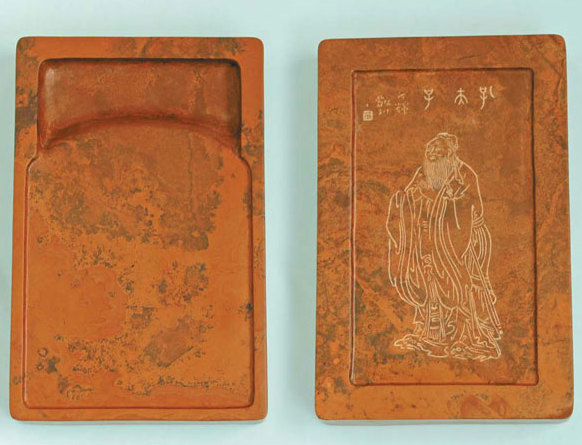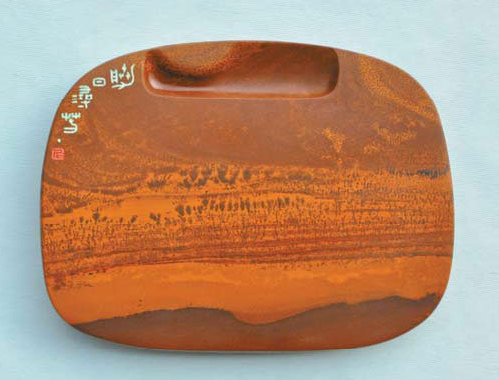Art for art's sake
Updated: 2013-04-19 08:21
By Ji Xiang (China Daily)
|
||||||||
|
An inkstone inscribed with a portrait of the philosopher Confucius. Photos Provided to China Daily |
Inkstones, the ancient chinese equivalent of the artist's mixing palette, are a combination of natural beauty and delicate craftsmanship
In traditional Chinese art there are four common subjects, known as the "four gentlemen" - plum blossom, orchid, bamboo and chrysanthemum. They are matched by four artists' tools - brush, ink, paper and inkstone - that in some cases have become works of art in themselves worthy of the most prestigious gallery space.
Throughout Chinese history these tools have been essential to both painters and calligraphers, with their quality playing an important role in the creation of masterpieces.
Inkstones, the Chinese equivalent of a painter's mixing palette, are arguably the most beautiful of them, often ornately carved from stone, with delicate engravings.
Chinese inkstones differ according to geography, with the material they are made from being a major distinctive feature.
Perhaps the most unique of them is Nishan inkstone, from Shandong province. It is named after Nishan Hill, next to the city of Qufu, where the legendary philosopher Confucius, whose ideas shaped Chinese culture, is said to have been born in a cave. Because of this connection, Nishan inkstones are often inscribed with Confucian philosophy.
The history of Nishan inkstone can be traced back to the Ming dynasty (1368-1644) in historical documents.
During the epoch of feudal rule, Nishan Hill, as the birthplace of Confucius, was strongly protected by the government, and this had the effect of enhancing the reputation of Nishan inkstone.
Nishan inkstone was once a rare item, owned mainly by celebrities and emperors. That changed in 1978 when a factory in Qufu began to produce it again.
Since then it has become a regular feature at Chinese and international exhibitions.
Nishan inkstone is normally pale grey-yellow, pale fawn, pale cream-brown or parchment colored and often comes inscribed with pine tree patterns.
The stone is medium hard and contains minerals such as quartz and pyrite, which make it easier to grind ink on and reduce damage to brushes.
Other minerals, including illite and chlorite, maintain the inkstone's shelf life as well as helping the ink to remain wet longer on the stone.
According to Ding Hui, a Nishan inkstone expert from Qufu, "What makes Nishan inkstone different from other types is the natural stone patterns it has, each one different. It is also special because of its connection to Confucius."
Nishan inkstone, "isn't picky in terms of partners", he says, meaning it is suitable for all kinds of paint and brushes.
Besides being an artist's tool, Nishan inkstone is today a collector's item, with the number of high-quality stones fairly limited. Pine tree or wave patterned stones are the most collectable, reflecting an appreciation of the beauty of nature that runs throughout much traditional Chinese art.
Ding is skilled in making inkstones and says the most difficult part of the process is being able to imagine the final inkstone when faced with the raw stone material. It is important to work with the existing patterns of the stone, he says, using them to improve the final product.
Once the theme of the inkstone has been decided, the carving can begin. This starts with cutting the pond where the ink will go and smoothing the edges of the stone. In some cases this can be a relatively easy process if the stone bears a natural inkstone shape.
The best inkstones are not about how much carving goes into their creation, but about the concept behind them and blending craftsmanship with nature, he says.
Nishan inkstone, like Shandong inkstones in general, relies on simplicity for its beauty. It looks more rugged and perhaps honest to its task than many other inkstones, a combination of practicality, craftsmanship and natural beauty. It is perhaps one of few artists' tools in the world that has itself become a work of art.
jixiang@chinadaily.com.cn
|
The inkstone Looking for flowers in the spring gets its name from a poem by a Song Dynasty Confucian scholar, Zhu Xi. |
(China Daily 04/19/2013 page18)

 Li Na on Time cover, makes influential 100 list
Li Na on Time cover, makes influential 100 list
 FBI releases photos of 2 Boston bombings suspects
FBI releases photos of 2 Boston bombings suspects
 World's wackiest hairstyles
World's wackiest hairstyles
 Sandstorms strike Northwest China
Sandstorms strike Northwest China
 Never-seen photos of Madonna on display
Never-seen photos of Madonna on display
 H7N9 outbreak linked to waterfowl migration
H7N9 outbreak linked to waterfowl migration
 Dozens feared dead in Texas plant blast
Dozens feared dead in Texas plant blast
 Venezuelan court rules out manual votes counting
Venezuelan court rules out manual votes counting
Most Viewed
Editor's Picks

|

|

|

|

|

|
Today's Top News
Boston bombing suspect reported cornered on boat
7.0-magnitude quake hits Sichuan
Cross-talk artist helps to spread the word
'Green' awareness levels drop in Beijing
Palace Museum spruces up
First couple on Time's list of most influential
H7N9 flu transmission studied
Trading channels 'need to broaden'
US Weekly

|

|










